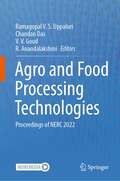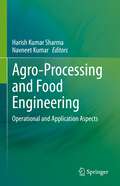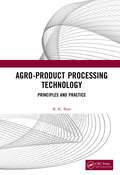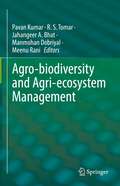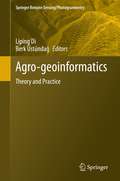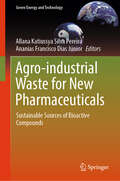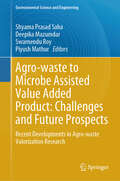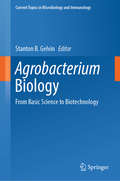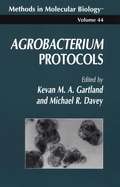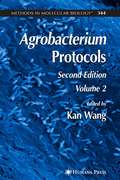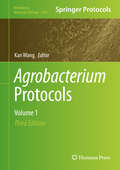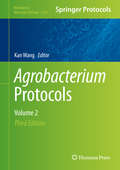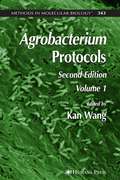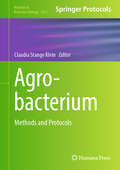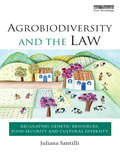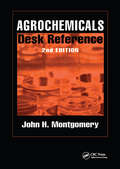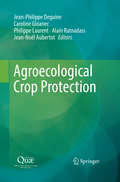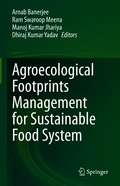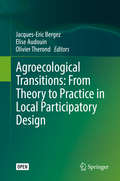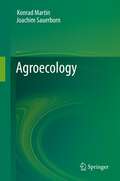- Table View
- List View
Agro and Food Processing Technologies: Proceedings of NERC 2022
by Chandan Das Ramagopal V. S. Uppaluri V. V. Goud R. AnandalakshmiThis book focuses on sustainable agro and food technologies for the northeast region of India and provides holistic insights into relevant and contextual scientific and technical advances in the agro-food sector. Agriculture is an important livelihood avenue for many residents of northeast India. Low-cost scientific and technological intervention can transform agricultural farm produces and generate farm waste into processed value-added products. This book will serve as a valuable resource to further enhance the linkage between managerial aspects and technological knowledge systems in this field and eventually catalyse potential knowledge frameworks for the long-term prosperity and sustainability of bio-diversity-rich North-east India. It emphasizes the research culture that needs to be adopted for the most relevant food and agro-processing technologies for the sustainable growth and prosperity of the region.
Agro-Environmental Sustainability in MENA Regions (Springer Water)
by Mohamed Abu-Hashim Abdelazim Negm Faiza Khebour AlloucheThis book focuses on the status quo and the latest information on the water-soil-agriculture nexus in the MENA countries. It presents several case studies and applications from e.g. Morocco, Algeria, Tunisia, Egypt and Jordan, while also sharing and discussing the latest findings. The content includes a range of agriculture-related topics that focus on: water resources management, impacts of climate change, and wastewater treatment for reuse in agriculture sectors; in addition, sustainable approaches to agricultural-based industry, organic crop production, crop water requirements, and soil environment are discussed in an updated and comprehensive review. In turn, the book discusses the applications of GIS and remote sensing as a new technology for better agriculture management, as well as its use in Egypt as a representative country. In closing, it considers the implementation of an environmental information system in data-scarce MENA countries from the standpoint of the water-food nexus, and addresses the question of climate justice in the MENA region. Exploring various dimensions of MENA country-based case studies on achieving sustainable agriculture, the book offers an invaluable source of topical information for agricultural sustainability-related stakeholders in the region, researchers and graduate students alike.
Agro-Processing and Food Engineering: Operational and Application Aspects
by Harish Kumar Sharma Navneet KumarThis textbook highlights the engineering fundamentals and processing aspects of agricultural produce and covers important aspects of agro-processing and food engineering in one place. The chapters cover material handling, drying, size reduction process, mixing and forming, cleaning and separation, storage, and processing of cereals, pulses, oilseeds, fruit and vegetables, and their products. The book’s contents are systematically designed to provide a balanced overview of agro-processing techniques from the basic concepts to the case study, handling of the materials, and different unit operations. The systematic and simple elaboration of scientific aspects will make it unique and help to develop skills in the field. Many illustrations in form of diagrams/charts/pictures provide a clear understanding. Solved numerical problems, which are given in the chapters, will provide students clarity in conceptualizing the basics. The book covers the syllabus related to agro-processing and food engineering at the undergraduate and postgraduate level in various universities, agricultural universities, allied institutes, and colleges across the globe. It will be extremely beneficial to students as it covers the most important and relevant topics, which are hardly covered in any other single compilation and published textbooks. It would be a good textbook for universities, agricultural universities, institutes, and colleges running courses in agriculture, horticulture, postharvest technology, process and food engineering, food engineering, food engineering and technology, food technology, food science, and food and nutrition.
Agro-Product Processing Technology: Principles and Practice
by B K BalaGlobal food security is a challenging issue. Meeting the food and nutritional requirements of the world has become an issue for national policymakers and is of public concern. There is a need to enhance agricultural production, as well as, to reduce postharvest loss, improve the quality of processed products, and add value to products to make more quality food available. Agro-product processing technology plays a major role to reduce post-harvest losses, improve the quality of processed products, and add value to the products. It also generates employment and ultimately contributes to food security. Features: Covers a wide spectrum of agro-product processing technology Explains the principles and practices of agro-product processing technology with many worked examples to quickly teach the basic principles through examples Contains examples from different operations on current problems to show the wide applications of the principles of agro-product technology Includes process control and emerging technologies in agro-product processing such as energy and exergy analysis, neural network modeling, and CFD modeling This book deals with physical and thermal properties, cleaning and sorting, drying and storage, parboiling and milling, by-product utilization, heating and cooling, refrigerated cooling, and cold storage. The most unique feature of this book is the machine vision for grading fruits, process control and materials handling, and emerging technologies such as neural network, finite element, CFD, and genetic algorithm.
Agro-Technology
by R. Paul ThompsonHumans have been modifying plants and animals for millennia. The dawn of molecular genetics, however, has kindled intense public scrutiny and controversy. Crops, and the food products which include them, have dominated molecular modification in agriculture. Organisations have made unsubstantiated claims and scare mongering is common. In this textbook Paul Thompson presents a clear account of the significant issues - identifying harms and benefits, analysing and managing risk - which lie beneath the cacophony of public controversy. His comprehensive analysis looks especially at genetically modified organisms, and includes an explanation of the scientific background, an analysis of ideological objections, a discussion of legal and ethical concerns, a suggested alternative - organic agriculture - and an examination of the controversy's impact on sub-Saharan African countries. His book will be of interest to students and other readers in philosophy, biology, biotechnology and public policy.
Agro-Waste Derived Biopolymers and Biocomposites: Innovations and Sustainability in Food Packaging
by Santosh Kumar Vimal Katiyar Avik MukherjeeAGRO-WASTE DERIVED BIOPOLYMERS AND BIOCOMPOSITES This comprehensive book describes the fundamental principles and major advancements in the utilization of agro-waste for deriving biopolymers, and their applications to fabricate composite, nanocomposite, and hybrid food packaging films and coatings. The book serves as a complete, systematic, comprehensive account of the contemporary developments in the area of novel and environment-friendly valorization of agro- and food wastes into value-added products like biodegradable polymer and active functional agents for food packaging applications. It also describes the hurdles and challenges in the commercialization of these novel biopolymer-based materials, including their composites, their applications, safety, and legal ramifications. This book consists of fifteen chapters covering different aspects of agro- and food waste utilization, the development of biodegradable polymers, and their composites for sustainable food packaging applications. The first thirteen chapters detail the processing of various agro- and food wastes of plant and animal origin to synthesize different biopolymers, such as starch, cellulose, chitosan, silk proteins, pectin, etc., and their applications for the fabrication of sustainable food packaging materials and composites that are attractive alternatives to synthetic plastic packaging. These chapters also summarize the effectiveness of these biopolymers and their composites in developing active films and edible coatings for shelf-life extension and preservation of perishable foods. A chapter is devoted to issues of biodegradability, including analyses of various biodegradation reactions, such as depolymerization, mineralization, biochemical, and abiotic degradation both in soil and aquatic environments. The book concludes with a chapter addressing the concerns associated with the possible migration of components or additives from these biodegradable packaging into packaged food items. Audience The primary audience for this book is researchers, scientists, and engineers working in food science and technology, food engineering and technology, food biotechnology, sustainable food packaging, etc. Additionally, food entrepreneurs and associated businesses, such as the packaging and coatings industries, will also have a keen interest in the book.
Agro-biodiversity and Agri-ecosystem Management
by Pavan Kumar Meenu Rani Jahangeer A. Bhat R. S. Tomar Manmohan DobriyalThis edited book collates latest findings in the field of agro-biodiversity and agri-ecosystem management across the globe through selected case studies. The primary aim of the book is to cover agro-biodiversity and agri-ecosystem advancements in the field of agricultural resource management. The book explores a range of technologies that support sustainable use of resources and facilities, such as Natural Resource Management (NRM), Resource Conservation Technologies (RCTs), Integrated Farming System (IFS), Integrated Crop Management (ICM), Integrated Nutrient Management (INM), use of solar energy, promotion of agro-ecological zone specific agricultural production, application of climate resilient technologies, secondary agricultural practices and post-harvest technologies. Agro-biodiversity and agri-ecosystem not only contributes to overall growth of the economy but also reduces poverty by providing employment and food security to the majority of the population in the continent and thus it is the most inclusive growth sectors of the economy of Asian and African countries. The book is relevant for researchers and policy makes in the field of agriculture, food system research, ecology, agricultural diversification, resource management etc.
Agro-geoinformatics: Theory and Practice (Springer Remote Sensing/Photogrammetry)
by Liping Di Berk ÜstündağThis volume collects and presents the fundamentals, tools, and processes of utilizing geospatial information technologies to process remotely sensed data for use in agricultural monitoring and management. The issues related to handling digital agro-geoinformation, such as collecting (including field visits and remote sensing), processing, storing, archiving, preservation, retrieving, transmitting, accessing, visualization, analyzing, synthesizing, presenting, and disseminating agro-geoinformation have never before been systematically documented in one volume. The book is edited by International Conference on Agro-Geoinformatics organizers Dr. Liping Di (George Mason University), who coined the term “Agro-Geoinformatics” in 2012, and Dr. Berk Üstündağ (Istanbul Technical University) and are uniquely positioned to curate and edit this foundational text.The book is composed of eighteen chapters that can each stand alone but also build on each other to give the reader a comprehensive understanding of agro-geoinformatics and what the tools and processes that compose the field can accomplish. Topics covered include land parcel identification, image processing in agricultural observation systems, databasing and managing agricultural data, crop status monitoring, moisture and evapotranspiration assessment, flood damage monitoring, agricultural decision support systems and more.
Agro-industrial Perspectives on Sugarcane Production under Environmental Stress
by Vishnu D. Rajput Krishan K. Verma Xiu-Peng Song Sushil Solomon Yang-Rui Li Govind P. RaoThis edited volume focuses on the core aspects of sugarcane production-management under stressful environments as well as innovative strategies for augmenting crop growth & productivity through intrinsic and extrinsic manipulations. The various chapters aim at bringing out comprehensive and advance information on different aspects of sugarcane cultivation under stress environments and impact of climate change on the sustainability of sugarcane production. The book encompasses information about crop production management, physiological & nutritional requirements, ratooning, ripening and post-harvest losses management. It also delineates various technologies that support the continued use and improvement of sugarcane as renewable source of food, fiber and bio-energy. The manipulations at cellular and molecular levels, molecular breeding approaches and post-harvest technologies are also included. The area under sugarcane cultivation is gradually increasing because of its diversification potential. The high productivity and biomass of the cane crop also makes it a key source for use as bio-energy crop and a promising raw material for bio-based agro-industries. However, poor crop & biomass productivity due to abiotic stress is the foremost constraint in its future commercial exploitation as sustainable feed-stock for bio-based industries. It is therefore imperative to understand the cellular-molecular modulation responsible to productivity barrier under specific stress situation(s) for better sugarcane quality and quantum under field condition. Some of these innovative approaches are delineated in this book. This book is of interest to progressive sugarcane growers, millers, industrial entrepreneurs, sugarcane scientists, cane development and extension officers, sugar industry managers and valuable source of reference worldwide.
Agro-industrial Waste for New Pharmaceuticals: Sustainable Sources of Bioactive Compounds (Green Energy and Technology)
by Allana Katiussya Silva Pereira Ananias Francisco Dias JúniorThis book is written to foster discussions on the valorization of agro-industrial waste as a raw material for bioactive compounds that can assist in disease containment, the protection of soil resources, and consequently, human health. The agro-industry encompasses a broad spectrum of activities focused on transforming raw materials from agriculture, livestock, aquaculture, and forestry. In addition to producing a diverse range of goods, these processes generate substantial amounts of residual biomass from various cultivation and processing systems. In this context, the intensification of climate change and the overexploitation of natural resources have been major drivers of emerging infectious diseases. A recent and impactful example is SARS-CoV-2, which escalated into a global pandemic with severe mortality rates. Additionally, Latin America has experienced a sharp rise in dengue cases, prompting the Pan American Health Organization to issue an epidemiological alert due to the increasing incidence of arboviruses across the region. Given the need to explore possibilities for valuing and utilizing agro-industrial waste, this book presents the potential of this material in the context of human health. The authors present a comprehensive review of recent research on pyroligneous liquid as a rich source of bioactive compounds, alongside the use of biochar and bone char in water treatment and herbicide immobilization in soil. Additionally, the book provides an in-depth analysis of methodologies for extracting bioactive compounds from &“açaí&” (Euterpe oleracea and E. precatoria) waste, highlighting its potential for high-value applications. In this way, the book highlights the challenges and opportunities to transform these materials into beneficial resources, both for the environment and for society, contributing to the advancement of public health and environmental conservation in the context of climate change.
Agro-waste to Microbe Assisted Value Added Product: Recent Developments in Agro-waste Valorization Research (Environmental Science and Engineering)
by Swarnendu Roy Piyush Mathur Shyama Prasad Saha Deepika MazumdarThis book mainly focuses on the recent trends and sustainability challenges in the valorization of agro-wastes, emphasizing the role of microbial biotechnology. Processing of various kinds of agro-wastes such as lignocellulosic materials, food industry wastes, dairy wastes, etc., into several bioactive compounds, enzymes, biofuels, biogas, biofertilizers, nutraceuticals, nanoparticles, etc., will be discussed elaborately in more detail. This book investigates the theoretical and practical aspects of modern research regarding the valorization of agro-wastes through microbial technology. Moreover, the role of valorization research in circular bio-economy will also be addressed in this book.
Agrobacterium Biology: From Basic Science to Biotechnology (Current Topics in Microbiology and Immunology #418)
by Stanton B. GelvinThis volume reviews various facets of Agrobacterium biology, from modern aspects of taxonomy and bacterial ecology to pathogenesis, bacterial cell biology, plant and fungal transformation, natural transgenics, and biotechnology. Agrobacterium-mediated transformation is the most extensively utilized platform for generating transgenic plants, but modern biotechnology applications derive from more than 40 years of intensive basic scientific research. Many of the biological principles established by this research have served as models for other bacteria, including human and animal pathogens. Written by leading experts and highlighting recent advances, this volume serves both as an introduction to Agrobacterium biology for students as well as a more comprehensive text for research scientists.
Agrobacterium Protocols (Methods in Molecular Biology #44)
by Michael R. Davey Kevan M. GartlandAgrobacterium Protocols offers beginning and experienced researchers the most comprehensive collection of step-by-step protocols for the genetic manipulation of plants using Agrobacterium. The topics range from the maintenance of bacterial culture collections to aspects of the metabolism and physiology of transformed tissues and transgenic plants. Drawing on the work of leading scientists from laboratories around the world, Agrobacterium Protocols provides a wealth of techniques for introducing specific DNA sequences into target plant species and discusses the environmental implications of genetically engineered plants. Its detailed procedures will facilitate rapid transfer of advanced techniques to other laboratories and their exploitation in fundamental and applied plant biology.
Agrobacterium Protocols, Second Edition, Volume 2: Volume II (Methods in Molecular Biology #344)
by Kan WangAgrobacterium tumefaciens is a soil bacterium that for more than a century has been known as a pathogen causing the plant crown gall disease. Unlike many other pathogens, Agrobacterium has the ability to deliver DNA to plant cells and permanently alter the plant genome. The discovery of this unique feature 30 years ago has provided plant scientists with a powerful tool to genetically transform plants for both basic research purposes and for agric- tural development. Compared to physical transformation methods such as particle bomba- ment or electroporation, Agrobacterium-mediated DNA delivery has a number of advantages. One of the features is its propensity to generate single or a low copy number of integrated transgenes with defined ends. Integration of a single transgene copy into the plant genome is less likely to trigger “gene silencing” often associated with multiple gene insertions. When the first edition of Agrobacterium Protocols was published in 1995, only a handful of plants could be routinely transformed using Agrobacterium. Ag- bacterium-mediated transformation is now commonly used to introduce DNA into many plant species, including monocotyledon crop species that were previously considered non-hosts for Agrobacterium. Most remarkable are recent devel- ments indicating that Agrobacterium can also be used to deliver DNA to non-plant species including bacteria, fungi, and even mammalian cells.
Agrobacterium Protocols, Third Edition, Volume 1: Volume 1 (Methods in Molecular Biology #1223)
by Kan WangRapid changes and significant progress have been made in the Agrobacterium field, such as genetically transforming plants for both basic research purposes and agricultural development. In Agrobacterium Protocols, Third Edition, Volumes 1 and 2, a team of leading experts and veteran researchers describe in detail techniques for delivering DNA to plant cells and permanently altering their genomes. This edition emphasizes agricultural crops and plant species with economic values, with updated protocols on 32 plant species and protocols involving 19 new species. Together with the 1st and 2nd editions, these two volumes offer Agrobacterium-mediated genetic transformation protocols for a total of 76 plant species. For a number of important plants such as rice, barley, wheat and citrus, multiple protocols using different starting plant materials for transformation are included.<P><P> Volume 1 details updated techniques available for 18 plant species drawn from cereal crops, legume plants, vegetable plants, and three model plant species: Brachypodium distachyon, Medicago truncatula, and Setaria viridis. It also updates a chapter for vector construction, a step critical to a successful plant transformation process. Written in the highly successful Methods in Molecular Biology series format, chapters include introductions to their respective topics, lists of the necessary materials and reagents, step-by-step, readily reproducible laboratory protocols, and tips on troubleshooting and avoiding known pitfalls.<P><P> Authoritative and cutting-edge, Agrobacterium Protocols, Third Edition facilitates the transfer of this rapidly developing technology to all researchers for use in both fundamental and applied biology.
Agrobacterium Protocols, Third Edition, Volume 2: Volume 2 (Methods in Molecular Biology #1224)
by Kan WangRapid changes and significant progress have been made in the Agrobacterium field, such as genetically transforming plants for both basic research purposes and agricultural development. In Agrobacterium Protocols, Third Edition, Volumes 1 and 2, a team of leading experts and veteran researchers describe in detail techniques for delivering DNA to plant cells and permanently altering their genomes. This edition emphasizes agricultural crops and plant species with economic values, with updated protocols on 32 plant species and protocols involving 19 new species. Together with the 1st and 2nd editions, these two volumes offer Agrobacterium-mediated genetic transformation protocols for a total of 76 plant species. For a number of important plants such as rice, barley, wheat and citrus, multiple protocols using different starting plant materials for transformation are included. Volume 2 contains 29 chapters with updated techniques for industrial plants, root plants, nuts and fruits, tropic plants, and other important plant species. Written in the highly successful Methods in Molecular Biology series format, chapters include introductions to their respective topics, lists of the necessary materials and reagents, step-by-step, readily reproducible laboratory protocols, and tips on troubleshooting and avoiding known pitfalls.<P><P> Authoritative and cutting-edge, Agrobacterium Protocols, Third Edition facilitates the transfer of this rapidly developing technology to all researchers in both fundamental and applied biology.
Agrobacterium Protocols: Volume I (Methods in Molecular Biology #343)
by Kan WangAgrobacterium tumefaciens is a soil bacterium that for more than a century has been known as a pathogen causing the plant crown gall disease. Unlike many other pathogens, Agrobacterium has the ability to deliver DNA to plant cells and permanently alter the plant genome. The discovery of this unique feature 30 years ago has provided plant scientists with a powerful tool to genetically transform plants for both basic research purposes and for agricultural development. Compared to physical transformation methods such as particle bomba- ment or electroporation, Agrobacterium-mediated DNA delivery has a number of advantages. One of the features is its propensity to generate a single or a low copy number of integrated transgenes with defined ends. Integration of a single transgene copy into the plant genome is less likely to trigger “gene silencing” often associated with multiple gene insertions. When the first edition of Agrobacterium Protocols was published in 1995, only a handful of plants could be routinely transformed using Agrobacterium. Agrobacterium-mediated transformation is now commonly used to introduce DNA into many plant species, including monocotyledon crop species that were previously considered non-hosts for Agrobacterium. Most remarkable are recent developments indicating that Agrobacterium can also be used to deliver DNA to non-plant species including bacteria, fungi, and even mammalian cells.
Agrobacterium: Methods and Protocols (Methods in Molecular Biology #2911)
by Claudia Stange KleinThis volume details Agrobacterium strain methods, such as plant genotype, transient and stable transformation of plants for gene overexpression, silencing, transplastomic and editing. Transformation protocols are focused mainly in plants with economic importance such as cereals and fruit trees including diploids and polyploids, and in non-plant species such fungi and algae. Written in the highly successful Methods in Molecular Biology series format, chapters include introductions to their respective topics, lists of the necessary materials and reagents, step-by-step, readily reproducible laboratory protocols, and key tips on troubleshooting and avoiding known pitfalls. Authoritative and cutting-edge, Agrobacterium: Methods and Protocols aims to be a useful and practical guide to new researchers and experts looking to expand their knowledge.
Agrobiodiversity and the Law: Regulating Genetic Resources, Food Security and Cultural Diversity
by Juliana SantilliA wide range of crop genetic resources is vital for future food security. Loss of agricultural biodiversity increases the risk of relying on a limited number of staple food crops. However, many laws, such as seed laws, plant varieties protection and access and benefit-sharing laws, have direct impacts on agrobiodiversity, and their effects have been severely underestimated by policy-makers. This is of concern not only to lawyers, but also to agronomists, biologists, and social scientists, all of whom need clear guidance as to the relevance of the law to their work. This book analyzes the impact of the legal system on agrobiodiversity (or agricultural biodiversity) – the diversity of agricultural species, varieties, and ecosystems. Using an interdisciplinary approach, it takes up the emerging concept of agrobiodiversity and its relationship with food security, nutrition, health, environmental sustainability, and climate change. It assesses the impacts on agrobiodiversity of key legal instruments, including seeds laws, the International Convention for the Protection of New Varieties of Plants, plant breeders’ rights, the Convention on Biological Diversity (regarding specifically its impact on agrobiodiversity), and the International Treaty on Plant Genetic Resources for Food and Agriculture. It also reviews the options for the implementation of these instruments at the national level in several countries. It discusses the interfaces between the free software movement, the ‘commons’ movement, and seeds, as well as the legal instruments to protect cultural heritage and their application to safeguard agrobiodiversity-rich systems. Finally, it analyzes the role of protected areas and the possibility of using geographical indications to enhance the value of agrobiodiversity products and processes.
Agrochemicals Desk Reference
by John H. MontgomeryThe Agrochemicals Desk Reference is a revised volume inspired by the growing number of research publications and continued interest in the fate, transport, and remediation of hazardous substances. Much data has been added to this edition, reflecting the wealth of literature in the field. Featured are environmental and physical/chemical data on more than 200 compounds, including pesticides, herbicides, and fungicides. All compounds are listed in alphabetical order, making it easy to find the data you need. The text is fully indexed by CAS number, RTECS number, empirical number, and synonyms.
Agrochemicals in Soil and Environment: Impacts and Remediation
by Sarvajeet Singh Gill M. Naeem Abid Ali Ansari Juan Francisco Jimenez BremontThis volume ‘Agrochemicals in Soil and Environment: Impacts and Remediation’ is a comprehensive collection of important literature on agrochemical contamination. The main focus of this book is to point out undesirable changes in biological, physical and chemical characteristics of agricultural soils and its impacts on global agricultural crop productivity. Soil is one of the important resources of basic needs for our sustenance but due to various anthropogenic activities like urbanization and industrialization, the soil is losing its basic quality characteristics. Soil microorganisms, water holding capacity, minerals, salts and nutrients are under the direct threat due to agrochemicals therefore, agricultural sector is facing a serious challenge. Lack of proper knowledge and luxurious applications of agrochemicals resulting into degradation and deterioration of soil quality, loss of soil and crop productivity and threatening the food security. Therefore, it is imperative to develop indices, indicators and soil parameters for the monitoring and impact assessment of agricultural contaminants. Further, biotic and abiotic stresses and their tolerance mechanisms in plants in relation to the soil contaminants such as toxic pollutants, heavy metals, inorganic and organic matters, variety of pesticides, insecticides, herbicides, agricultural runoffs and solid wastes, and chemical fertilizers are also highlighted in this volume. This book also discusses causes of reduced agriculture productivity and suggests sustainable measures such as plant-based technologies, bioremediation and nanotechnology, that can be used to overcome the crop losses. The book is interest to research students, teachers, agricultural scientists, agronomists, environmentalists as well as policy makers.
Agroecological Crop Protection
by Jean-Philippe Deguine Caroline Gloanec Philippe Laurent Alain Ratnadass Jean-Noël AubertotThis book is devoted to Agroecological Crop Protection, which is the declension of the principles of agroecology to crop protection. It presents the concepts of this innovative approach, case studies and lessons and generic keys for agroecological transition. The book is intended for a wide audience, including scientists, experimenters, teachers, farmers, students. It represents a new tool, proposing concrete keys of action on the basis of feedbacks validated scientifically. Beyond the examples presented, it is therefore of general scope and proposes recommendations for all temperate and tropical cropping systems. It contributes to the training and teaching modules in this field and it is an updated information support for professionals and a teaching aid for students (agronomy, crop protection, biodiversity management, agroecology).
Agroecological Footprints Management for Sustainable Food System
by Ram Swaroop Meena Manoj Kumar Jhariya Arnab Banerjee Dhiraj Kumar YadavAgroecological footprints are a unique and popular concept for sustainable food system. Measuring and keeping a tab on the agroecological footprints of various human activities has gained remarkable interest in the past decade. From a range of human activities, food production and agriculture are most essential as well as extremely dependent on the agroecosystems. It is therefore crucial to understand the interaction of agroecosystem constituents with the extensive agricultural practices. The environmental impact measured in terms of agroecological footprints for a healthy for the sustainable food system. The editors critically examine the status of agroecological footprints and how it can be maintained within sustainable limits. Drawing upon research and examples from around the world, the book is offering an up-to-date account, and insight into how agroecology can be implemented as a solution in the form of eco-friendly practices that would boost up the production, curbs the environmental impacts, improves the bio-capacity, and reduces the agroecological footprints.It further discusses the changing status of the agroecological footprints and the growth of other footprint tools and types, such as land, water, carbon, nitrogen, etc. This book will be of interest to teachers, researchers, government planners, climate change scientists, capacity builders, and policymakers. Also, the book serves as additional reading material for undergraduate and graduate students of agriculture, agroforestry, agroecology, soil science, and environmental sciences.National and international agricultural scientists, policymakers will also find this to be useful to achieve the ‘Sustainable Development Goals’.
Agroecological Transitions: From Theory To Practice In Local Participatory Design
by Jacques-Eric Bergez Elise Audouin Olivier TherondThis Open Access book presents feedback from the ‘Territorial Agroecological Transition in Action’- TATA-BOX research project, which was devoted to these specific issues. The multidisciplinary and multi-organisation research team steered a four-year action-research process in two territories of France. It also presents:i) the key dimensions to be considered when dealing with agroecological transition: diversity of agriculture models, management of uncertainties, polycentric governance, autonomies, and role of actors’ networks;ii) an operational and original participatory process and associated boundary tools to support local stakeholders in shifting from a shared diagnosis to a shared action plan for transition, and in so doing developing mutual understanding and involvement;iii) an analysis of the main effects of the methodology on research organisation and on stakeholders’ development and application;iv) critical analysis and foresights on the main outcomes of TATA-BOX, provided by external researchers.
Agroecology
by Joachim Sauerborn Konrad MartinThis book represents an interdisciplinary approach to the relevant aspects of agricultural production related to the interactions between natural processes, human activities and the environment. It provides condensed and comprehensive knowledge on the functions of various agroecosystems at the field, landscape and global scale. Understanding and integrating complex ecological processes into field production, land management and food systems is essential in order to deal with the challenges of modern crop and livestock production: the need for food security for the growing human population, and the necessity to combat the detrimental effects of food production on the environment. The book provides the scientific basis required by students and scientists involved in the development of sustainable agroecosystems and contributes to a range of disciplines including Agriculture, Biology, Geography, Landscape Ecology, Organic Farming, Biological Control, and Global Change Ecology.
